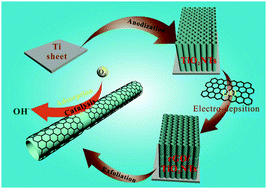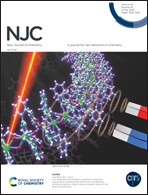Titania nanotubes coated with graphene as a promising catalyst for the oxygen reduction reaction†
Abstract
The research on non-noble metal oxide catalysts is significant for solving the problems of high cost, low abundance and poor stability of platinum-based catalysts used in the oxygen reduction reaction of fuel cells. In this study, a novel non-noble metal electrocatalyst consisting of a titanium dioxide nanotube (TiO2NTs) array and reduced graphene oxide (rGO) was prepared using a facile chronoamperometry route. High-resolution transmission electron microscopy (HRTEM) and mapping images clearly show that rGO is tangled on the TiO2 nanotube wall. The comparative study on the electrocatalytic performance of rGO, TiO2NTs, rGO/TiO2NTs and commercial Pt/C for the oxygen reduction reaction (ORR) reveals that rGO/TiO2NTs shows a more positive onset potential, higher current density, and higher electron transfer number (∼4) in alkaline media compared with bulk TiO2NTs and rGO for the ORR, and a better durability and methanol tolerance than the commercial Pt/C catalyst, which may be attributed to the synergetic effects between TiO2NTs and rGO. The rGO is coated on a well-organized TiO2 nanotube wall improving the stability and conductivity, thus further improving the catalytic performance. It will open up a new strategy for developing effective non-noble metal oxide catalysts for the oxygen reduction reaction.



 Please wait while we load your content...
Please wait while we load your content...